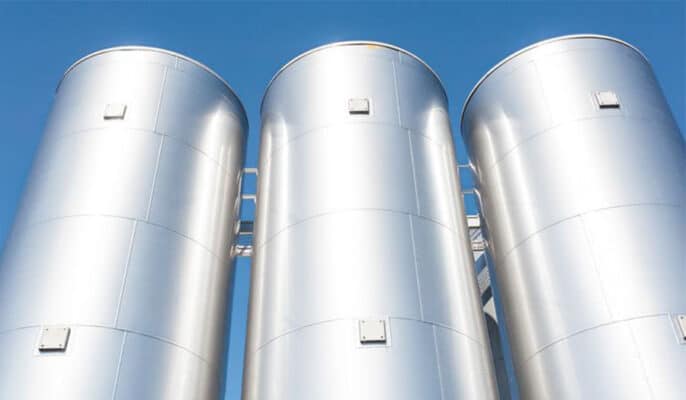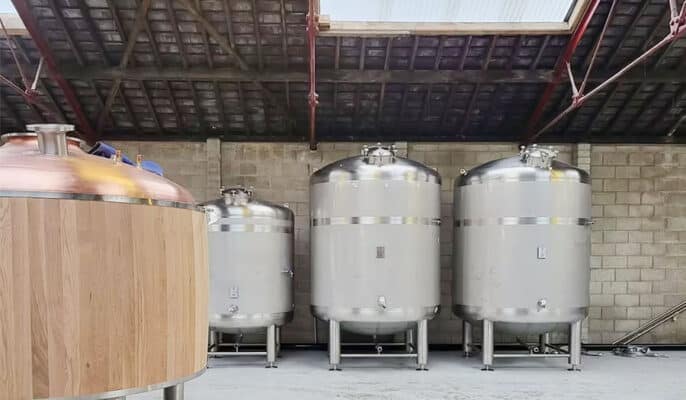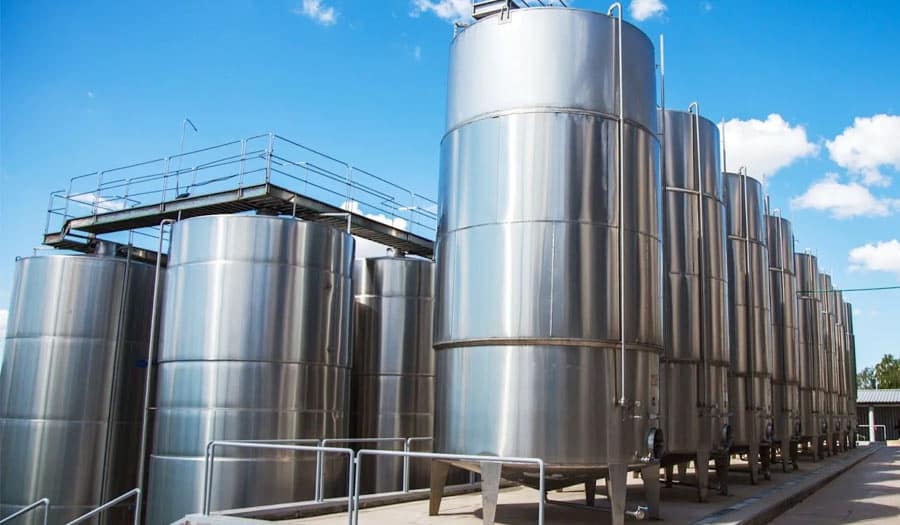Les cuves de stockage en acier inoxydable jouent un rôle essentiel dans l'industrie et la fabrication modernes. Leur tâche principale est de stocker et de traiter diverses substances liquides et semi-liquides de manière sûre et efficace. Grâce à leur excellente résistance à la corrosion, leur solidité et leur durabilité, ces cuves de stockage sont largement utilisées dans de nombreuses industries telles que l'industrie alimentaire, l'industrie des boissons, l'industrie chimique, l'industrie pharmaceutique, etc. Dans l'industrie alimentaire et des boissons, les cuves de stockage en acier inoxydable sont non seulement utilisées pour stocker les matières premières, les liquides de fermentation et les produits finis, mais elles permettent également de garantir efficacement la qualité et la sécurité des produits.
Qu'est-ce qu'un acier inoxydable ? réservoir de stockage?
Un réservoir de stockage en acier inoxydable est un réservoir spécialisé fabriqué en acier inoxydable. Elle est principalement utilisée pour stocker et manipuler diverses substances liquides et semi-liquides. En raison de leurs excellentes propriétés physiques et chimiques, les cuves en acier inoxydable sont largement utilisées dans de nombreuses industries, telles que l'industrie alimentaire, l'industrie des boissons, l'industrie chimique et l'industrie pharmaceutique.
Les principales caractéristiques des réservoirs de stockage en acier inoxydable sont les suivantes :
- Résistance à la corrosion : Les matériaux en acier inoxydable présentent une excellente résistance à la corrosion, ce qui permet à ces réservoirs de stockage d'être utilisés pendant longtemps dans des environnements liquides corrosifs tels que les acides, les alcalis et les sels, sans être facilement endommagés. Cette caractéristique est particulièrement importante lors de la manipulation de produits chimiques ou du stockage de liquides à forte humidité.
- Résistance et durabilité : L'acier inoxydable présente une résistance et une robustesse excellentes et peut supporter certaines pressions et certains chocs mécaniques. Ces réservoirs peuvent donc stocker en toute sécurité des substances lourdes ou à haute pression.
- Hygiène : L'acier inoxydable a une surface lisse et est facile à nettoyer et à désinfecter, ce qui est particulièrement important dans les industries alimentaires et pharmaceutiques car il peut empêcher efficacement l'accumulation de bactéries et de contaminants, garantissant ainsi l'hygiène et la sécurité du produit.
- Résistance à la température : Les cuves de stockage en acier inoxydable peuvent maintenir des performances stables dans des environnements à haute ou basse température. Elles conviennent donc aux situations de stockage qui nécessitent un contrôle de la température, telles que la transformation des aliments et la production pharmaceutique.
- Étanchéité : Ces réservoirs de stockage sont généralement équipés d'excellents systèmes d'étanchéité, qui peuvent empêcher efficacement les fuites de liquide et protéger les matériaux stockés de la contamination ou de l'interférence de l'environnement extérieur.

Principales fonctions des réservoirs de stockage en acier inoxydable
- Stockage et conservation : Ces réservoirs constituent une solution idéale pour le stockage de matériaux à grande échelle, réduisant efficacement les pertes qui peuvent être causées par l'évaporation ou le déversement. Ils permettent de gérer efficacement les stocks, d'assurer un approvisionnement stable en matériaux nécessaires aux opérations continues et d'éviter les pénuries.
- Mélange : Certaines cuves de stockage en acier inoxydable sont conçues pour mélanger différents liquides ou gaz afin d'obtenir des formules ou des produits spécifiques.
- Transport : Les réservoirs de stockage portables conviennent au transport de liquides ou de gaz sur de courtes distances, ce qui facilite les opérations mobiles dans les chaînes de production ou d'approvisionnement.
- Sécurité et conformité : Le stockage approprié des matières dangereuses permet de respecter les réglementations en matière de sécurité et d'environnement et de garantir la sécurité et la conformité pendant les opérations.
- Tampon : Les réservoirs de stockage agissent comme des tampons entre les taux de production et les taux de consommation, aidant à équilibrer les fluctuations de la demande et de l'offre et à maintenir une production et des ventes stables.
- Des applications polyvalentes : En outre, les cuves de stockage en acier inoxydable sont également largement utilisées pour stocker des liquides de nettoyage, des produits pharmaceutiques, des produits chimiques, etc. et, grâce à leur polyvalence, elles jouent un rôle important dans divers processus de production.
Les types de réservoirs de stockage en acier inoxydable peuvent être classés en fonction de leur forme, de leur fonction et de leur conception spéciale.
Classification des formes
- Réservoir de stockage cylindrique : Le type le plus courant, composé d'un cylindre et d'un dôme ou d'un toit plat. Sa géométrie simple permet de réduire les coûts de fabrication tout en offrant une bonne résistance structurelle et une bonne stabilité.
- Réservoir de stockage sphérique : Comme sa forme ronde répartit uniformément la pression interne, il convient au stockage de liquides ou de gaz à haute pression et fonctionne de manière stable sous haute pression.
- Réservoir de stockage vertical : Placé verticalement, il occupe une petite surface et convient aux environnements où l'espace est limité. Sous l'action de la gravité, le liquide s'écoule naturellement, ce qui contribue à réduire les coûts de maintenance et d'exploitation.
- Réservoir de stockage horizontal : Il est placé horizontalement, convient aux espaces spacieux, favorise la distribution uniforme des liquides et est facile à nettoyer et à entretenir.
- Réservoir de stockage à double couche : Il possède une structure à deux couches, intérieure et extérieure, la couche extérieure servant de couche de protection et la couche intérieure étant utilisée pour stocker les liquides. La conception à double couche offre une protection supplémentaire et empêche efficacement l'influence de l'environnement extérieur sur le liquide stocké.
Classification par type de fonction
- Cuve de fermentation: Il est utilisé dans les processus de fermentation microbienne et est équipé de systèmes de contrôle de la température, d'agitation et de canaux de gaz pour assurer la stabilité et l'uniformité du processus de fermentation. La conception est axée sur le nettoyage, la désinfection et le contrôle de la température et de la pression.
- Réservoir de mélange : utilisé pour mélanger uniformément différents ingrédients, il est généralement équipé d'un dispositif d'agitation. La conception est axée sur l'effet de mélange et l'uniformité.
- Réservoir de stockage : principalement utilisé pour stocker des substances liquides ou semi-liquides, la conception se concentre sur la capacité de stockage et la stabilité, et comprend généralement des systèmes d'ouverture, de décharge et de contrôle du niveau de liquide.
Classification spéciale de la conception
- Réservoir de stockage isolé : ajouter une couche d'isolation à l'extérieur du réservoir pour maintenir la température du liquide interne stable et réduire la consommation d'énergie et les fluctuations de température.
- Réservoir de stockage chauffant/refroidissant : équipé d'un système de chauffage ou de refroidissement pour maintenir le liquide dans une plage de température spécifique, y compris des réchauffeurs, des serpentins de refroidissement ou des thermostats.

Matériau du réservoir
Le choix du matériau pour la construction d'un réservoir est crucial et dépend de la nature chimique de la substance à stocker, des conditions environnementales, des considérations de coût et de la durée de vie prévue du réservoir. Ces matériaux présentent différents avantages et sont sélectionnés en fonction de facteurs tels que le type de substance stockée, les exigences de durabilité, la rentabilité et la résistance à la corrosion ou aux réactions chimiques.
- L'acier : Largement utilisé pour sa durabilité et sa résistance. Les différentes qualités d'acier offrent divers degrés de résistance à la corrosion en fonction du matériau stocké. Il peut être recouvert ou revêtu pour prévenir la corrosion et convient à une large gamme de températures et de pressions.
- Béton : Grands réservoirs utilisés pour stocker l'eau, les eaux usées et certains produits chimiques. Le béton présente une bonne intégrité structurelle et une bonne résistance au feu, et il est rentable dans le cadre d'une production à grande échelle.
- Polyéthylène et fibre de verre : Ces matériaux sont utilisés pour fabriquer des réservoirs résistants aux produits chimiques ou des réservoirs d'eau de petite et moyenne taille et présentent une excellente résistance à la corrosion. Toutefois, ils peuvent ne pas convenir aux applications à haute pression.
- Acier inoxydable : Par rapport à l'acier ordinaire, l'acier inoxydable résiste à la corrosion et n'est pas réactif. Il peut donc être utilisé dans les cuves destinées au stockage de produits chimiques corrosifs ou d'aliments.
Comment préserver la sécurité des cuves de stockage en acier inoxydable ?
Une manipulation, un stockage et un entretien corrects des réservoirs de stockage, ainsi que des inspections régulières et la formation des employés, peuvent contribuer à prévenir les accidents, les fuites et les incendies. En respectant les consignes de sécurité et les réglementations, les entreprises peuvent s'assurer que leurs réservoirs de stockage sont sûrs et conformes aux réglementations locales, protégeant ainsi leurs employés, leurs équipements et l'environnement contre les risques potentiels.
- Des mesures de sécurité incendie, notamment des extincteurs, des détecteurs de fumée et des systèmes d'extinction automatique, doivent être mises en œuvre pour prévenir les incendies. Les employés qui manipulent des matières stockées doivent être formés à la manipulation sûre, aux procédures de stockage, à la lutte contre les fuites et à l'intervention d'urgence. Des formations régulières et des réunions de sécurité peuvent renforcer les pratiques de sécurité et garantir que les employés sont conscients des risques associés aux réservoirs de stockage.
- L'inspection et l'entretien réguliers des réservoirs de stockage sont essentiels pour garantir leur bon fonctionnement et éviter les fuites et les déversements. Les entreprises qui s'occupent du stockage en vrac doivent tenir des registres des inspections, de l'entretien et des essais des réservoirs de stockage et des équipements connexes.
- Des systèmes de détection et de surveillance des fuites, tels que des systèmes de jaugeage automatique des réservoirs ou d'autres dispositifs de surveillance électronique, doivent être installés pour détecter rapidement les fuites ou les déversements. Des systèmes de confinement secondaires, tels que des digues ou des bassins de confinement, doivent également être installés pour empêcher les déversements de se propager en dehors de la zone de confinement.
- Le stockage d'autres matières dangereuses, telles que le gaz de pétrole liquéfié, est également important. Les réservoirs de stockage de GPL doivent être protégés contre tout accès non autorisé afin de réduire le risque d'interférence intentionnelle ou accidentelle. Les utilisateurs de GPL sont responsables de leurs réservoirs et doivent notamment veiller à ce qu'ils soient sûrs.
Comment choisir une cuve de stockage en acier inoxydable ?
- Capacité : Déterminez avec précision la capacité de stockage requise et évitez de choisir un réservoir trop grand ou trop petit. Cela permet de garantir l'efficacité du stockage tout en évitant les investissements inutiles ou les restrictions de capacité.
- Sélection du matériau : Choisir le matériau approprié en fonction de la nature et des exigences de la substance stockée. Les matériaux courants sont l'acier, l'aluminium, le polyéthylène et la fibre de verre, chacun ayant ses avantages spécifiques, tels que la durabilité et la résistance à la corrosion.
- Respecter les réglementations : Assurez-vous que le réservoir choisi est conforme à toutes les réglementations pertinentes en matière de sécurité et d'environnement afin de prévenir les risques potentiels et de garantir la conformité avec les exigences légales en vigueur dans la région.
- Caractéristiques de sécurité : Choisissez des réservoirs qui répondent aux normes et réglementations en matière de sécurité, en donnant la priorité à leurs performances en matière de sécurité afin de réduire les risques d'accidents, de fuites et de dommages à l'environnement.
- Type de réservoir : Envisagez différents types de réservoirs, tels que les réservoirs hors sol, les réservoirs souterrains, les réservoirs portables, les réservoirs aériens, etc. Choisissez le type de réservoir le plus approprié en fonction des besoins de stockage spécifiques et des conditions du site.
- Considérations relatives aux coûts : Choisissez un réservoir dans les limites de votre budget, en veillant à trouver un équilibre entre la rentabilité et les performances, afin de répondre aux exigences de qualité et de fonctionnalité.
- Adaptation de la taille : En fonction de l'espace disponible et des besoins de stockage, il convient de choisir la bonne taille de réservoir pour s'assurer qu'il s'adapte au site et qu'il permet de stocker efficacement le volume requis.
- Disponibilité et adéquation : Au cours du processus de sélection, il faut s'assurer que le modèle de réservoir choisi répond au budget et aux exigences et qu'il est facilement disponible en cas de besoin pour répondre à des besoins de stockage spécifiques.
FAQ
Quelles sont les principales utilisations des cuves de stockage en acier inoxydable ?
R : Les réservoirs de stockage en acier inoxydable sont largement utilisés pour stocker et traiter diverses substances liquides et semi-liquides, notamment les aliments, les boissons, les produits chimiques, les produits pharmaceutiques, etc. Leur résistance à la corrosion et leur durabilité font qu'ils sont utilisés dans de nombreuses industries, telles que la transformation des aliments, la production de produits pharmaceutiques, chimiques et de boissons.
Les réservoirs de stockage en acier inoxydable doivent-ils faire l'objet d'inspections régulières ?
Oui, les cuves de stockage en acier inoxydable doivent être inspectées régulièrement pour garantir leur fonctionnement normal. L'inspection comprend le contrôle de la structure, de l'étanchéité, de la corrosion et d'autres facteurs susceptibles d'affecter le fonctionnement du réservoir. Une inspection et un entretien réguliers peuvent contribuer à prolonger la durée de vie du réservoir de stockage et à garantir sa sécurité.
Quelle est la durée de vie d'un réservoir de stockage en acier inoxydable ?
La durée de vie d'un réservoir de stockage en acier inoxydable dépend de nombreux facteurs, notamment du matériau, de l'environnement d'utilisation, de l'entretien et des conditions de fonctionnement. D'une manière générale, les cuves de stockage en acier inoxydable 304 et 316 peuvent être utilisées pendant plus de 15 ans dans des conditions normales d'utilisation et d'entretien. Toutefois, la durée de vie réelle peut varier en fonction de l'application spécifique et des conditions environnementales.




